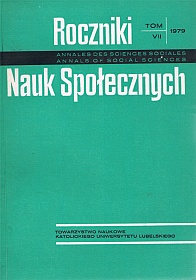Traditional rural religiosity (the Polish case)
Abstract
Following the definition -of C.P.G. Tilanus: „traditional religiosity" as proper behavior and' Attitudes which are bound by a causal union in some determined areas of life, the author devotes Some space to the concept of „tradition" because of its ambiguity. Three differant variants of this Concept are distinguished in the literature of the subject. The author uses the „subject variant” i.e. an evaluative relation towards the past (the cultural heritage). If this relation of people is affirmative in an unconscious, passive way, we have the „traditional relation"; if, however, the past becomes the chief value of our life, an element of a Weltanschaung, e.g. in the case of threatening the value system of-a society, one should use the term „traditionalist".
Having criticized four stereotypes in the sociology of religion in Poland, i.e. the identification of traditional religiosity with the rural people; the belief that it means the intensity and devotion in practicing rites; the belief that it is identified with the division of generations; the opinion that traditional village religiosity was in essence shaped in the feudal-corv6e period, the author discusses on the basis of the literature published after 1956, the main characteristics of rural religiosity because it is the principal subject of interest of Polish sociologists who are concerned with the „traditional religiosity". These characteristics, altogether 43. are strongly differentiated and scattered in Polish works. This proves the relative nature of the phenomenon and, hence, requires reference points.
So the Author compares two villages; a Polish one (on the basis of his own research in the S. Poland) and a Canadian (on the basis of H. Miner's book: St Denis. A French-Canadian Parish, 1939). They differ strongly in respect of their ecology, and politico-cultural history (a.o. in the Polish village the corv6e system survived til 1846, in the latter·—-it didn’t exist at all); however, they manifest in a striking way the same type of religiosity. Then three types of religiosity which can be found in Polish novels of the XX c. are discussed by the author: the traditional, the traditionalist as well as folk-anachronistic (mostly in the eyes of the Marxist writers), Analysis of the 12 Polish village monographs which examine the problem of traditional religiosity, also proves the existence of many differences among their authors: only 9 features were mentioned by at least half the authors (6) of all the 21 enumerated features.
A similar situation appears in general ethnographic or theoretical sociological works (by Bystron, Chalasinski, Czarnowski, Thomas and Znaniecki). Special attention is paid by the author to the relative nature of the concept „traditional" as it appears in the Polish Peasant in Europe and America in the analysis of the evolution of types of rural religiosity.
In general, the image of rural religiosity in Polish sociology is so strongly differentiated, according to different authors and the aspect accepted by them that it is impossible to elaborate on this basis even a representative list of features of the phenomenon in question. So the author of the article comes out with a delination of the type of social relations in the condition of the Polish village in the first half of XX c., using here the Tonnies „Gemeinschaft-Gesellschaft" model. And with help of data from· the earlier analysis of the Polish (and one American) empirical as well theoretical works, the author constructs a verbal model of traditional folk religiosity, it embraces the following logically related features: collective solidarity (a mass cult and religiosity manifested externally and permeated by a feeling -of collective responsability); spontaneity of sentiments and low level of reflectiveness which is bound in with a lack of intellectual-doctrinal interests; an aversion to discussion (and to sects) as well as the absence of any inclinations to mysticism; rather moderate formalism and religious ritualism, indispensible in the type of mass (collective) participation in socio-religious life because they are simultanously means of control inand also of society over nature (in the subjective coaviction); and as elements of rational behavior in this type of society they are the cause of a certain disposition to fatalism, and also fanaticism, however, of a defensive character: the cultural uniformity which is inevitable in this situation limits individual commitment and internal religious experience.
The model constructed facilitates, in turn, explanation of various phenomena, often observed earlier, as for instance a certain discrepancy between approved principles and actual.,behavior. Which have been interpreted, however, in a misleading way.
Copyright (c) 1979 Roczniki Nauk Społecznych

This work is licensed under a Creative Commons Attribution-NonCommercial-NoDerivatives 4.0 International License.


